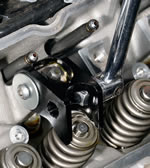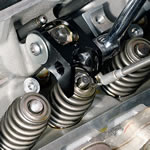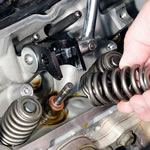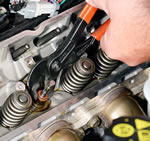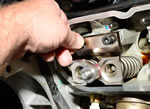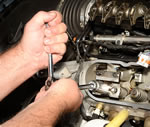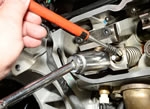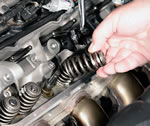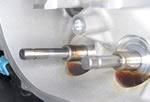C6 Corvette Z06: The Heads On Test - How to Perform Low-Accuracy Measurement of LS7 Valve Stem to Guide Clearance - Page 2 of 4
by Hib Halverson
© December 2014
No use without permission, All Rights Reserved
Start with the intake valve. To use the Lingenfelter compressor on offset intake rocker arms, set it on the rocker mount, twist the tool such that it aligns with the valve spring retainer then make the bolt finger tight. The load of spring compression is applied to the bolt in tension, so having the tool's pivot centerline at an angle to the rocker mount is not a problem. Attach a long-handle ratchet or a breaker bar and pull down on the handle-a lot of strength is not required-such that the retainer is depressed enough for you to remove the valve locks with a magnet. When you pull down on the compressor, if the valve goes down, too, release the pressure, loosen the rocker bolt and turn the tool out of the way. Pick a socket about the same diameter as the retainer, seat it on the retainer and give it a modest whack with a hammer. That will usually free the locks in the retainer. Recompress the spring, remove the locks, release the compressor and remove the retainer and spring. When you do an intake, the lash cap may come off with the retainer. We kept the locks, retainer and lash cap in a small plastic cup until we needed to reinstall them. Now, move the LPE spring compressor to the exhaust valve. Compress the spring, remove the locks then, release the pressure and remove the spring and retainer.
Observe this note of caution about the Lingenfelter Spring Compressor: be carful when compressing the spring to remove the locks and when compressing it again to reinstall the locks. Because the retainer moves in an arc, if the tool is not positioned properly on the spring/retainer package before compression, it's possible to scrape the valve stem with the edge of the retainer's inside diameter. As the spring nears full compression, carefully, observe the retainer I.D. as it descends. If it's too close to the stem, release pressure and reposition the compressor. If you score an exhaust valve stem, it will have to be cleaned-up with a fine abrasive; but if you score an intake valve stem, you destroy its CrN coating and and the valve must be scrapped. Given the cost of titanium intake valves, do the utmost to avoid stem damage. This problem is why we prefer the LSM Spring Compressor which Summit Racing sells, in spite of its significantly higher price.
The LMS tool is a little more time consuming to set-up, but it does both springs on a given cylinder simultaneously. First, set the rocker fulcrum adapter on the rocker arm fulcrums of cylinder in question. Back the big nut in the center out a ways, then, bolt the tool in place using the Allen bolts which come with it-finger tight is good enough. Use a 7/8-ths deep socket to carefully tighten the big nut, compressing the springs until you can use a magnet to grab the four locks. Run the bolt back up until you can remove the springs and retainers. Then, remove the tool and, if it didn't come off with its retainer, the intake valve lash cap.
With the springs out of the way, disconnect the air pressure then, use slip-joint pliers-we like 10-in Knipex (PN 8701250) for this-to gently work the valve stem seals loose from the spring seats in the heads and remove them. With the piston at TDC, the valves will drop slightly until their heads sit on the piston top. Now you're ready to wiggle.
